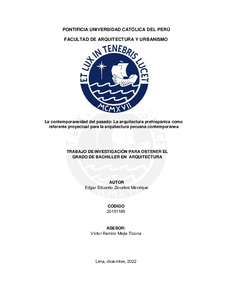| dc.contributor.advisor | Mejía Ticona, Víctor Ramiro | |
| dc.contributor.author | Zevallos Manrique, Edgar Eduardo | |
| dc.date.accessioned | 2023-03-24T02:05:23Z | |
| dc.date.available | 2023-03-24T02:05:23Z | |
| dc.date.created | 2022 | |
| dc.date.issued | 2023-03-23 | |
| dc.identifier.uri | http://hdl.handle.net/20.500.12404/24519 | |
| dc.description.abstract | La arquitectura prehispánica peruana destaca por su gran valor en el campo de la ingeniería
y de la arquitectura y, por ello, un reconocimiento a nivel internacional. Debido a su valor
arquitectónico y paisajístico, este representa un referente proyectual para los arquitectos y
estudiantes peruanos. Esta arquitectura prehispánica se transforma en una herramienta
proyectual para entender el territorio y clima peruano e intervenir pertinentemente en este
contexto. De esta manera, diversos arquitectos han incorporado estas estrategias en sus
proyectos e integrándolas como parte de su discurso. En este artículo, se analizarán tres
casos de estudio: el Museo de Pachacamac (2015) por Llosa Cortegana arquitectos; el
conjunto de casas W (2011) por Barclay&Crousse architecture; y la casa Pachacamac (2008)
por Luis Longhi. Se estudiarán las estrategias proyectuales, emplazamiento, materialidad y
su vínculo con la arquitectura prehispánica. Inclusive, se puede identificar una filiación entre
los proyectos producidos en estos últimos años. | es_ES |
| dc.description.abstract | Peruvian pre-Hispanic architecture stands out for its great value in the field of engineering and
architecture and, therefore, an international recognition. Due to its architectural and landscape
value, it represents a design reference for Peruvian architects and students. This pre-Hispanic
architecture becomes a project tool to understand the Peruvian territory and climate and
intervene appropriately in this context. In this way, various architects have incorporated these
strategies into their projects and integrated them as part of their discourse. In this article, three
case studies will be analyzed: Pachacamac Museum (2015) by Llosa Cortegana arquitectos;
W houses (2011) by Barclay & Crousse architecture; and Pachacamac house (2008) by Luis
Longhi. Project strategies, location, materiality, and its link with pre-Hispanic architecture will
be studied. Inclusively, an affiliation can be identified among the projects produced in recent
years. | es_ES |
| dc.language.iso | spa | es_ES |
| dc.publisher | Pontificia Universidad Católica del Perú | es_ES |
| dc.rights | info:eu-repo/semantics/openAccess | es_ES |
| dc.rights.uri | http://creativecommons.org/licenses/by-nc-sa/2.5/pe/ | * |
| dc.subject | Arquitectura moderna--Perú | es_ES |
| dc.subject | Arquitectura prehispánica--Perú | es_ES |
| dc.subject | Identidad cultural--Perú | es_ES |
| dc.title | La contemporaneidad del pasado: La arquitectura prehispánica como referente proyectual para la arquitectura peruana contemporánea | es_ES |
| dc.type | info:eu-repo/semantics/bachelorThesis | es_ES |
| thesis.degree.name | Bachiller en Arquitectura | es_ES |
| thesis.degree.level | Bachillerato | es_ES |
| thesis.degree.grantor | Pontificia Universidad Católica del Perú. Facultad de Arquitectura | es_ES |
| thesis.degree.discipline | Arquitectura | es_ES |
| renati.advisor.dni | 10556604 | |
| renati.advisor.orcid | https://orcid.org/0000-0003-0140-2274 | es_ES |
| renati.author.dni | 72857942 | |
| renati.discipline | 731026 | es_ES |
| renati.level | https://purl.org/pe-repo/renati/level#bachiller | es_ES |
| renati.type | https://purl.org/pe-repo/renati/type#trabajoDeInvestigacion | es_ES |
| dc.publisher.country | PE | es_ES |
| dc.subject.ocde | https://purl.org/pe-repo/ocde/ford#6.04.08 | es_ES |






